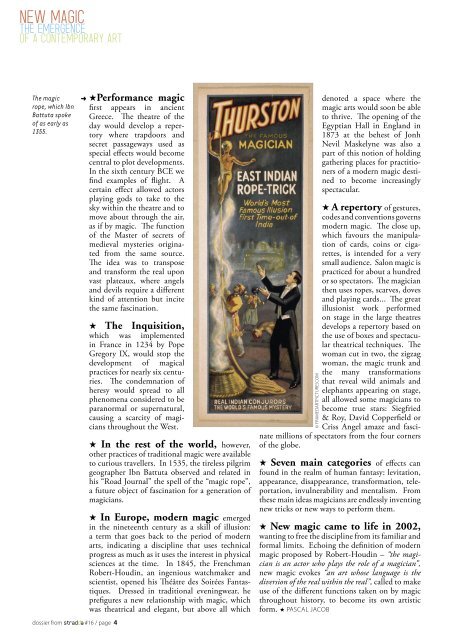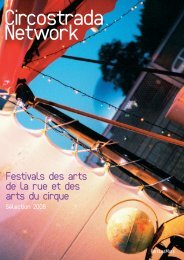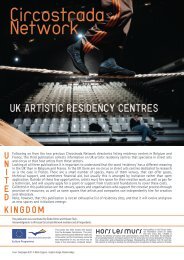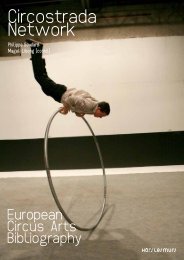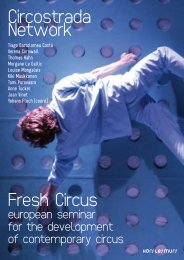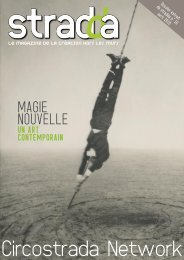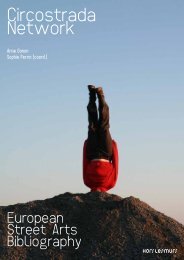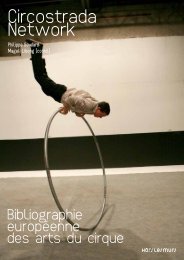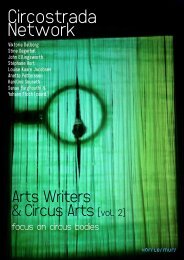MAGIE NOUVELLE - Circostrada Network
MAGIE NOUVELLE - Circostrada Network
MAGIE NOUVELLE - Circostrada Network
Create successful ePaper yourself
Turn your PDF publications into a flip-book with our unique Google optimized e-Paper software.
NEW MAGIC<br />
THE EMERGENCE<br />
OF A CONTEMPORARY ART<br />
The magic<br />
rope, which Ibn<br />
Battuta spoke<br />
of as early as<br />
1355.<br />
➜<br />
dossier from stradda #16 / page 4<br />
★Performance magic<br />
first appears in ancient<br />
Greece. The theatre of the<br />
day would develop a repertory<br />
where trapdoors and<br />
secret passageways used as<br />
special effects would become<br />
central to plot developments.<br />
In the sixth century BCE we<br />
find examples of flight. A<br />
certain effect allowed actors<br />
playing gods to take to the<br />
sky within the theatre and to<br />
move about through the air,<br />
as if by magic. The function<br />
of the Master of secrets of<br />
medieval mysteries originated<br />
from the same source.<br />
The idea was to transpose<br />
and transform the real upon<br />
vast plateaux, where angels<br />
and devils require a different<br />
kind of attention but incite<br />
the same fascination.<br />
★ The Inquisition,<br />
which was implemented<br />
in France in 1234 by Pope<br />
Gregory IX, would stop the<br />
development of magical<br />
practices for nearly six centuries.<br />
The condemnation of<br />
heresy would spread to all<br />
phenomena considered to be<br />
paranormal or supernatural,<br />
causing a scarcity of magicians<br />
throughout the West.<br />
★ In the rest of the world, however,<br />
other practices of traditional magic were available<br />
to curious travellers. In 1535, the tireless pilgrim<br />
geographer Ibn Battuta observed and related in<br />
his “Road Journal” the spell of the “magic rope”,<br />
a future object of fascination for a generation of<br />
magicians.<br />
★ In Europe, modern magic emerged<br />
in the nineteenth century as a skill of illusion:<br />
a term that goes back to the period of modern<br />
arts, indicating a discipline that uses technical<br />
progress as much as it uses the interest in physical<br />
sciences at the time. In 1845, the Frenchman<br />
Robert-Houdin, an ingenious watchmaker and<br />
scientist, opened his Théâtre des Soirées Fantastiques.<br />
Dressed in traditional eveningwear, he<br />
prefigures a new relationship with magic, which<br />
was theatrical and elegant, but above all which<br />
© FRAMEDARTPICTURESCOM<br />
denoted a space where the<br />
magic arts would soon be able<br />
to thrive. The opening of the<br />
Egyptian Hall in England in<br />
1873 at the behest of Jonh<br />
Nevil Maskelyne was also a<br />
part of this notion of holding<br />
gathering places for practitioners<br />
of a modern magic destined<br />
to become increasingly<br />
spectacular.<br />
★ A repertory of gestures,<br />
codes and conventions governs<br />
modern magic. The close up,<br />
which favours the manipulation<br />
of cards, coins or cigarettes,<br />
is intended for a very<br />
small audience. Salon magic is<br />
practiced for about a hundred<br />
or so spectators. The magician<br />
then uses ropes, scarves, doves<br />
and playing cards... The great<br />
illusionist work performed<br />
on stage in the large theatres<br />
develops a repertory based on<br />
the use of boxes and spectacular<br />
theatrical techniques. The<br />
woman cut in two, the zigzag<br />
woman, the magic trunk and<br />
the many transformations<br />
that reveal wild animals and<br />
elephants appearing on stage,<br />
all allowed some magicians to<br />
become true stars: Siegfried<br />
& Roy, David Copperfield or<br />
Criss Angel amaze and fascinate<br />
millions of spectators from the four corners<br />
of the globe.<br />
★ Seven main categories of effects can<br />
found in the realm of human fantasy: levitation,<br />
appearance, disappearance, transformation, teleportation,<br />
invulnerability and mentalism. From<br />
these main ideas magicians are endlessly inventing<br />
new tricks or new ways to perform them.<br />
★ New magic came to life in 2002,<br />
wanting to free the discipline from its familiar and<br />
formal limits. Echoing the definition of modern<br />
magic proposed by Robert-Houdin – “the magician<br />
is an actor who plays the role of a magician”,<br />
new magic evokes “an art whose language is the<br />
diversion of the real within the real”, called to make<br />
use of the different functions taken on by magic<br />
throughout history, to become its own artistic<br />
form. ★ PASCAL JACOB


